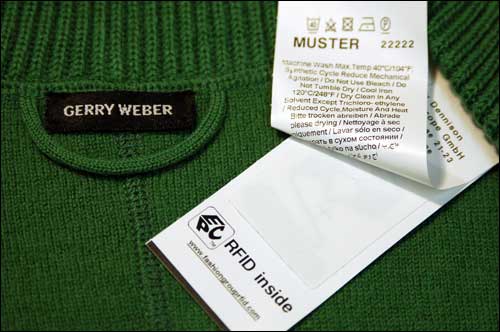Gerry Weber International, a Germany-based manufacturer of women’s fashions, has decided to apply EPC Gen 2 RFID tags to the 25 million garments it produces annually, beginning next year. The company also plans to roll out RFID technology at 150 of its company-owned retail stores in Germany and abroad. The application is designed to improve the efficiency of its incoming goods and inventory processes, and to function as an electronic article surveillance (EAS) system.
The RFID tags will be embedded into the garment-care labels that Gerry Weber sews into its clothing. The company claims it will be the first in Germany to sew RFID-enabled care labels into apparel, as well as the first to rely solely on RFID for EAS.
The company developed the garment-care labels together with global label company Avery Dennison. The garment-care labels will be applied during the manufacturing process, and will contain Avery Dennison’s AD-827 RFID inlays. The tags can be washed in water at a temperature of up to 60 degrees Celsius (140 degree Fahrenheit) without damage, and dry cleaning will not harm the inlays either. This is important, in case a garment needs to be cleaned before being sold. When the clothing is purchased at a store, Gerry Weber’s staff will cut off the RFID tags upon request from the customer. If a tag is not removed, however, it will remain functional only for up to three washing cycles.
Gerry Weber first gained experience with RFID through a trial involving Galeria Kaufhof, a department store chain operated by the Metro Group (see Retailer Tests RFID on Garments). Later, in 2008 and 2009, the firm participated in the Ko-RFID project, a federally funded research effort focused on the collaborative use of radio frequency identification (see Ko-RFID Tackles RFID Business Collaboration Processes).
Gerry Weber also conducted extensive, parallel tests of RFID on its own, in which it tested reusable RFID tags in its supply chain to monitor inbound goods, picking and outbound shipping. The tests were carried out at six warehouses, and at two of the company’s German retail stores. Partners for the test of RFID in logistics processes included IBM, which served as the project integrator, Checkpoint Systems, which provided reusable tags and RFID-enabled packing tables, OATSystems, which supplied middleware, and Intermec, which contributed the RFID handheld devices.
At a presentation at RFID Journal LIVE! Europe 2009, held in Germany in October, Ralph Tröger, an IT project manager at Gerry Weber, said his company learned from the logistics processes testing that it can gain “real value” from RFID, particularly by using the technology for picking and outbound shipping processes. However, he noted, some RFID hardware was too large for retail distribution centers, and handheld readers required improved battery life, and needed to be lighter.
In a second part of Gerry Weber’s trials, which took place in early 2009, the company tested RFID in retail processes. Partners included SALT Solutions, which designed and carried out the testing, Intermec, which again provided the handheld interrogator, and Checkpoint Systems, which supplied reusable tags. During Gerry Weber’s first business-case calculations for RFID, approximately two and a half years ago, the company could not calculate a return on investment (ROI) on one-use tags, which is why it decided to test reusable tags.
Gerry Weber tested the concept of reusable tags by having its clothing manufacturers in China apply several thousand of the tags to garments made in that country. However, the company reports, it found that reusable RFID tags were not suitable for the retail environment, because new product information must be associated with the tag’s unique ID number every time the tag is reused.
“The idea of RFID is to substitute and accelerate processes,” Tröger explains. “The irony is that when you use reusable tags, you have an additional process—to associate the product bar code with the RFID tag.”
In the third part of the trials, carried out during the spring, summer and autumn of 2009, Gerry Weber tested RFID for EAS at two stores, including one in Duesseldorf. Partners included Deutsche Telekom, which served as the project integrator, RAKO Security Label, which provided textile RFID tags, and Stonegarden Technologies, which supplied point-of-sale RFID interrogators and software for deactivating tags.
RFID is at least as effective as conventional EAS for theft detection, Tröger says. However, he notes, the psychological barrier for thieves considering stealing an item may be lower with RFID, since tags are less noticeable.
The three tests and later calculations helped Gerry Weber draw some important conclusions for its business: The company sees the most immediate business-case advantage of RFID as being in the retail store, Tröger explains, and believes that single-use tags applied to all of its merchandise, rather than just part of it, will bring about an ROI.
“Especially in the incoming goods receipt process, we had significant time savings,” Tröger states, “because employees no longer had to manually count items or scan their bar codes to find out if an order was complete.” Clerks simply scanned the bar code on the delivery note and interrogated the RFID tags in garments to match up delivery receipts with actual items shipped, he says. In addition, employees saved significant time by no longer having to attach and detach EAS security tags and take inventory.
“What’s even more important is that our customers don’t mind having RFID labels on their clothes,” Tröger says. The company prominently displayed information regarding the use of RFID on garments—but during the field tests, he notes, it did not receive a single query about its RFID use.
Gerry Weber’s board studied the test results and the business-case analysis, and decided that the retailer should adopt RFID garment-care labels for all of its apparel in 2010. It also decided it should employ RFID for EAS and other retail processes at select stores, and use the technology for select logistics processes handled by its logistics providers. Gerry Weber outsources all of its logistics to two providers.
The EAS system, which complies with EPCglobal and GS1 standards (see GS1 Releases Guidelines for RFID-based Electronic Article Surveillance), works by removing a tag’s EPC ID number from the database once an item is purchased. If the EPC number is removed, an item can be taken past an EAS portal and be removed from the store without an alarm sounding.
According to Tröger, Gerry Weber chose Avery Dennison because it has been a long-time partner and was the first company capable of providing Gerry Weber with tags that met its specifications. The clothing manufacturer picked Deutsche Telekom to provide the readers and antennas, including a powerful radio antenna it designed especially for the RFID-based EAS portals at store entrances and exits. Other partners for the rollout include SALT Solutions, which is supplying the retail merchandising system and developed the software for using RFID in retail processes, and Torex, a solutions provider for the retail sector, which is integrating RFID into the cash register system.
When a tagged item is purchased, a clerk will first read the bar code on the price tag, after which the computer system activates the RFID antenna and interrogator beneath the checkout counter. The RFID system then reads the EPC number encoded to the garment’s RFID tag, and removes it from the database.
Gerry Weber intends to invest €2.7 million ($4.1 million) in RFID over the course of five years, Tröger says, and estimates it will recoup that expense within two years following deployment. The company will do so, he notes, by purchasing far fewer hard plastic tags for use with conventional EAS systems. What’s more, its logistics partners will save time by no longer having to attach the hard plastic EAS tags to garments at their distribution centers, and will be able to pass along those savings. The logistics partners will also save time spent receiving incoming goods and monitoring delivery quality.
Gerry Weber foresees opportunities for suppliers and partners that will arise from its plan to sew RFID tags into all garments it produces. The firm is encouraging all companies with which it does business to take advantage of its tagging, in order to improve their processes and services by implementing RFID read points in the supply chain, or at other points.
The company is also willing to help its competitors adopt RFID technology, Tröger says. “Our competitors are invited to use our solution,” he states. “We don’t want a proprietary solution. We want our competitors to adopt EPCglobal standards so that we can all benefit from lower prices for RFID technology.”
Already, DHL is planning a pilot project with Gerry Weber at a logistics center that the shipping services company uses for Gerry Weber. After a concept is fully developed the DHL Innovation Center, DHL Global Forwarding will implement, test and roll out a system, such as one that utilizes RFID readers to identify goods at the item level and compare the products received with actual shipping orders. Like Gerry Weber, DHL has a long history of testing RFID technology, including a project involving RFID-enabled delivery vans (see DHL Says Its SmartTrucks Save Money, Time and CO2).
Gerry Weber operates 338 stores, as well as 1,400 shop-in-shop areas, and reported a turnover in fiscal year 2007/2008 of €570 million ($858 million).



